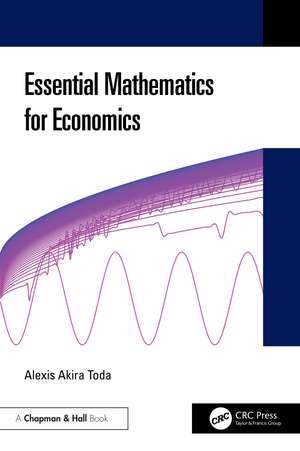Essential Mathematics for Economics
Autor Alexis Akira Todaen Limba Engleză Paperback – 8 oct 2024
Features
- Replete with exercises and illuminating examples
- Suitable as a primary text for an advanced undergraduate or postgraduate course on mathematics for economics
- Basic linear algebra and real analysis are the only prerequisites.
- Supplementary materials such as Matlab codes, teaching slides etc. are posted on the book website https://github.com/alexisakira/EME.
| Toate formatele și edițiile | Preț | Express |
|---|---|---|
| Paperback (1) | 387.96 lei 3-5 săpt. | +27.01 lei 4-10 zile |
| CRC Press – 8 oct 2024 | 387.96 lei 3-5 săpt. | +27.01 lei 4-10 zile |
| Hardback (1) | 955.45 lei 6-8 săpt. | |
| CRC Press – 8 oct 2024 | 955.45 lei 6-8 săpt. |
Preț: 387.96 lei
Nou
Puncte Express: 582
Preț estimativ în valută:
74.23€ • 77.72$ • 61.43£
74.23€ • 77.72$ • 61.43£
Carte disponibilă
Livrare economică 17-31 martie
Livrare express 28 februarie-06 martie pentru 37.00 lei
Preluare comenzi: 021 569.72.76
Specificații
ISBN-13: 9781032698946
ISBN-10: 1032698942
Pagini: 308
Ilustrații: 72
Dimensiuni: 156 x 234 x 20 mm
Greutate: 0.44 kg
Ediția:1
Editura: CRC Press
Colecția Chapman and Hall/CRC
Locul publicării:Boca Raton, United States
ISBN-10: 1032698942
Pagini: 308
Ilustrații: 72
Dimensiuni: 156 x 234 x 20 mm
Greutate: 0.44 kg
Ediția:1
Editura: CRC Press
Colecția Chapman and Hall/CRC
Locul publicării:Boca Raton, United States
Public țintă
Postgraduate and Undergraduate AdvancedCuprins
0. Roadmap. Section I. Introduction to Optimization. 1. Existence of Solutions. 1.1. Introduction. 1.2. The Real Number System. 1.3. Convergence of Sequences. 1.4. The Space rn. 1.5. Topology of rn. 1.6. Continuous Functions. 1.7. Extreme Value Theorem. 1.A. Topological Space. 2. One-Variable Optimization. 2.1. Introduction. 2.2. Differentiation. 2.3. Necessary Condition. 2.4. Mean Value and Taylor’s Theorem. 2.5. Sufficient Condition. 2.6. Optimal Savings Problem. 3. Multi-Variable Unconstrained Optimization. 3.1. Introduction. 3.2. Linear Maps and Matrices. 3.3. Differentiation. 3.4. Chain Rule. 3.5. Necessary Condition. 4. Introduction to Constrained Optimization. 4.1. Introduction. 4.2. One Linear Constraint. 4.3. Multiple Linear Constraints. 4.4. Karush-Kuhn-Tucker Theorem. 4.5. Inequality and Equality Constraints. 4.6. Constrained Maximization. 4.7. Dropping Nonnegativity Constraints. Section II. Matrix and Nonlinear Analysis. 5. Vector Space, Matrix, and Determinant. 5.1. Introduction. 5.2. Vector Space. 5.3. Solving Linear Equations. 5.4. Determinant. 6. Spectral Theory. 6.1. Introduction. 6.2. Eigenvalue and Eigenvector. 6.3. Diagonalization. 6.4. Inner Product and Norm. 6.5. Upper Triangularization. 6.6. Positive Definite Matrices. 6.7. Second-Order Optimality Condition. 6.8. Matrix Norm and Spectral Radius. 7. Metric Space and Contraction. 7.1. Metric Space. 7.2. Completeness and Banach Space. 7.3. Contraction Mapping Theorem. 7.4. Blackwell’s Sufficient Condition. 7.5. Perov Contraction. 7.6. Parametric Continuity of Fixed Point. 8. Implicit Function and Stable Manifold Theorem. 8.1. Introduction. 8.2. Inverse Function Theorem. 8.3. Implicit Function Theorem. 8.4. Optimal Savings Problem. 8.5. Optimal Portfolio Problem. 8.6. Stable Manifold Theorem. 8.7. Overlapping Generations Model. 9. Nonnegative Matrices. 9.1. Introduction. 9.2. Markov Chain. 9.3. Perron’s Theorem. 9.4. Irreducible Nonnegative Matrices. 9.5. Metzler Matrices. Section III. Convex and Nonlinear Optimization. 10. Convex Sets. 10.1. Convex Sets. 10.2. Convex Hull. 10.3. Hyperplanes and Half Spaces. 10.4. Separation of Convex Sets. 10.5. Cone and Dual Cone. 10.6. No-Arbitrage Asset Pricing. 11. Convex Functions. 11.1. Convex and Quasi-Convex Functions. 11.2. Convexity-Preserving Operations. 11.3. Differential Characterization. 11.4. Continuity of Convex Functions. 11.5. Homogeneous Quasi-Convex Functions. 11.6. Log-Convex Functions. 12. Nonlinear Programming. 12.1. Introduction. 12.2. Necessary Condition. 12.3. Karush-Kuhn-Tucker Theorem. 12.4. Constraint Qualifications. 12.5. Saddle Point Theorem. 12.6. Duality. 12.7. Sufficient Conditions. 12.8. Parametric Differentiability. 12.9. Parametric Continuity. Section IV. Dynamic Optimization. 13. Introduction to Dynamic Programming. 13.1. Introduction. 13.2. Knapsack Problem. 13.3. Shortest Path Problem. 13.4. Optimal Savings Problem. 13.5. Optimal Stopping Problem. 13.6. Secretary Problem. 13.7. Abstract Formulation. 14. Contraction Methods. 14.1. Introduction. 14.2. Markov Dynamic Program. 14.3. Sequential and Recursive Formulations. 14.4. Properties of Value Function. 14.5. Restricting Spaces. 14.6. State-Dependent Discounting. 14.7. Weighted Supremum Norm. 14.8. Numerical Dynamic Programming. 15. Variational Methods. 15.1. Introduction. 15.2. Euler Equation. 15.3. Transversality Condition. 15.4. Stochastic Case. 15.5. Optimal Savings Problem.
Notă biografică
Alexis Akira Toda was born in Montreal, Canada to a Japanese father and a French-Canadian mother and moved to Japan at the age of four. He received a B.A. in medicine from University of Tokyo in 2004 and then an M.A. in economics in 2008 while practicing anesthesia. He moved to the United States in 2008 and obtained a Ph.D. in economics from Yale University in 2013. After teaching mathematics for economics, mathematical economics, and finance at UC San Diego for eleven years, he moved to Emory University in 2024, where he is a professor of economics. He is the author of more than 40 research articles published in economics, mathematics, physics, and medical journals on a wide variety of topics including general equilibrium, macro-finance, consumption and savings, income and wealth distributions, asset price bubbles, power laws, dynamic programming, econometrics, and numerical methods, among others. He can be reached at https://alexisakira.github.io.
Descriere
This book covers mathematical topics that are essential for economic analysis in a concise but rigorous fashion. The book covers selected topics such as linear algebra, real analysis, convex analysis, constrained optimization, dynamic programming, and numerical analysis in a single volume.
